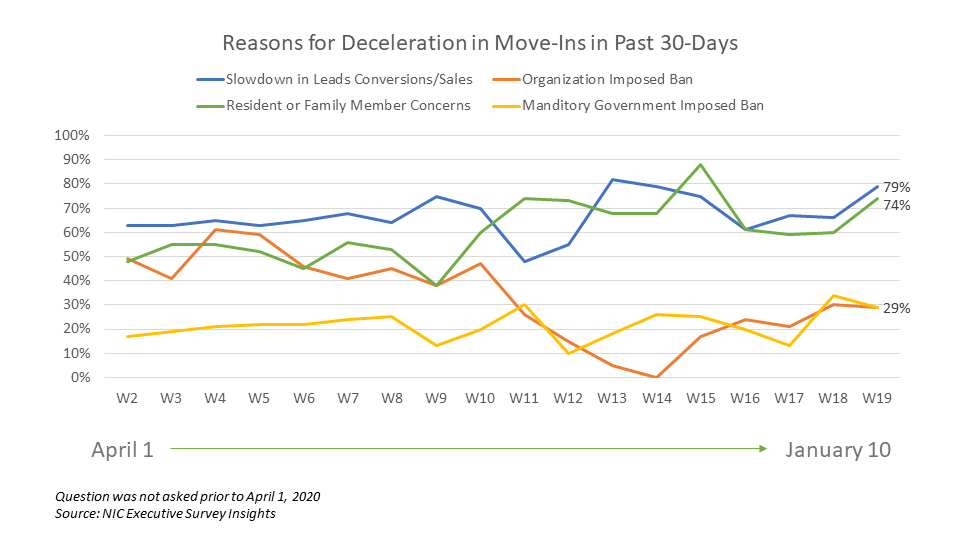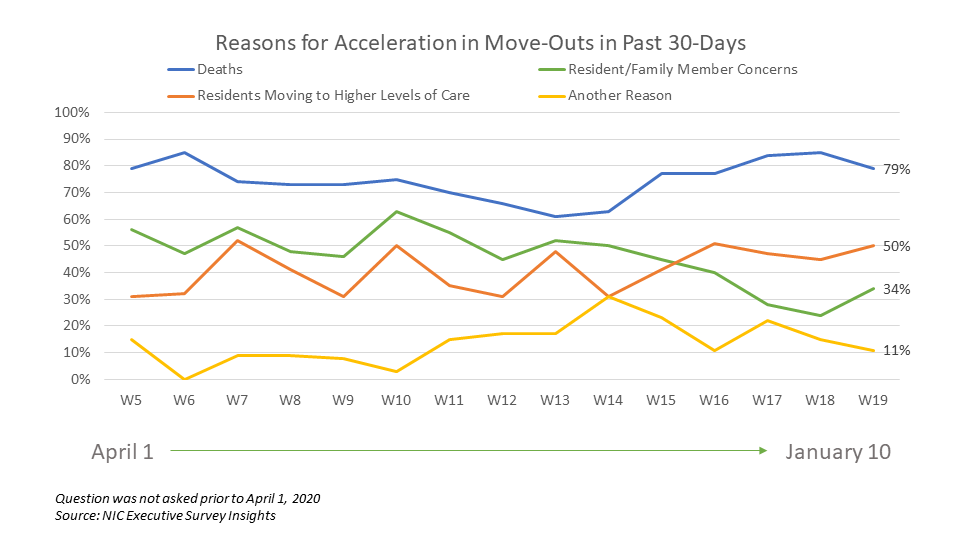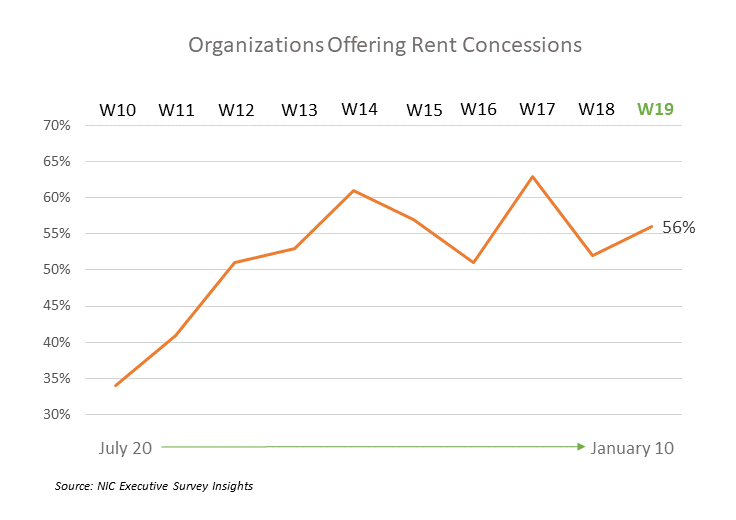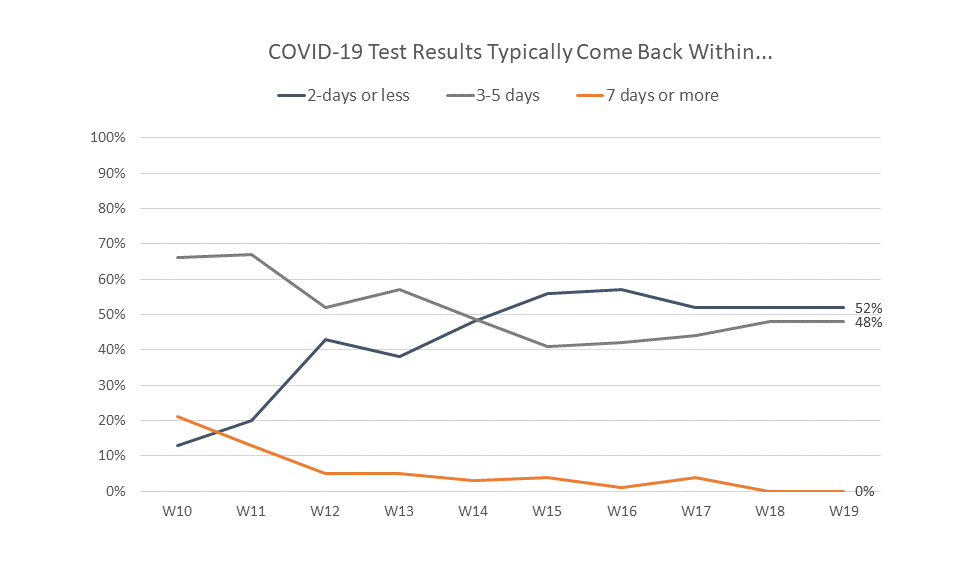“The drag on occupancy rates continued to be observed in the Wave 19 survey results. This likely reflects a combination of challenges in backfilling COVID-related vacancies as well as the effects of typical seasonality during the holidays and winter months. Despite reports of record-high COVID-19 cases across the country occurring daily, roughly two-thirds of respondent organizations were not increasing move-in restrictions presumably in part due to operator innovations in infection mitigation and creative visitation protocols which have gained acceptance from many residents and families. Long-anticipated as a game-changer with regard to improving occupancy, many operators are now starting to receive the COVID-19 vaccine. The Wave 20 survey is currently collecting data on the distribution of the vaccine to provide new insights for decision-makers.”
–Lana Peck, Senior Principal, NIC
NIC’s Executive Survey of operators in seniors housing and skilled nursing is designed to deliver transparency into market fundamentals in the seniors housing and care space at a time when market conditions continue to change. This Wave 19 survey includes responses collected from December 28, 2020, to January 10, 2021, from owners and executives of 86 seniors housing and skilled nursing operators from across the nation. Detailed reports for each “wave” of the survey and a PDF of the report charts can be found on the NIC COVID-19 Resource Center webpage under Executive Survey Insights.
Additionally, the full range of time series data for each wave of the survey by care segment for move-ins, move-outs and occupancy rate changes can be found HERE.
Wave 19 Summary of Insights and Findings
- In the Wave 19 survey, more respondents reported decelerations in the pace of move-ins than accelerations in move-ins for the independent living, memory care and nursing care segments. Apart from earlier in the pandemic, this has been the case for the past three surveys for independent living and memory care, and the past six surveys for nursing care. For the assisted living care segment, one third of survey respondents reported accelerations, one-third decelerations and one-third reported no change in the pace of move-ins. The shares of organizations reporting an acceleration in the pace of move-ins in the past 30 days for the independent living segment remained at or around its lowest level since Wave 8 (surveyed late-May to early-June). The full range of time-series data can be viewed here.

- Roughly three-quarters of organizations cited a slowdown in leads conversions/sales and/or resident or family member concerns as reasons for decelerations in the pace of in move-ins in the past 30-days (79% and 76%, respectively), up from about two-thirds in the Wave 18 survey. The approximately one-third of organizations that cited self-imposed or government-imposed moratoriums as a reason for the slowdown in settling new residents into their communities remained unchanged from the prior survey conducted at year-end 2020.

- One-quarter of respondents (26%) indicated that their organizations had a backlog of residents waiting to move in. This is down from a high of 34% reached in the Wave 16 survey and similar to levels last observed in Waves 12 through 15 conducted between mid-September to late October and early November.
- As in prior surveys, the majority of the organizations that responded to the Wave 19 Survey reported no change in the pace of move-outs for each of the care segments. However, the share of organizations that reported an acceleration in the pace of move-outs in the memory care segment increased from about one-quarter in the Wave 18 survey (23%) to one-third (33%) in the Wave 19 survey. The full range of time-series data can be viewed here.

- Shown in the chart below, resident deaths (unspecified reason) continued to be the most frequently cited reason for the acceleration in the pace of move-outs in the last 30-days (79%). This is up from 61% in Wave 13 and below the peak of 85% reached in the Wave 6 survey conducted in early-May. One-half of survey respondents cited residents moving to higher levels of care since the Wave 16 survey conducted in mid-November. Resident or family member concerns cited as a reason for move-outs (34%) was up from 24% in the prior survey.

- Three-quarters of organizations (78%) cited increased resident demand as a reason for acceleration in the pace of move-ins (down from a recent high of 84% in Wave 16). Presumably for various reasons including anecdotal reports of more hospital discharges of patients to home health, hospital placement cited as a reason for acceleration in the pace of move-ins (28%) continued to lag the survey time series high of 41% reached in Wave 10, conducted in late July.
- Between 45% and 57% of organizations with assisted living units, memory care units and/or nursing care beds, and 38% with independent living units, reported declines in occupancy in the past 30 days. For each of the care segments, the shares of organizations reporting occupancy declines continued to outpace those reporting higher occupancy. Considering recent survey data, this trend began in the Wave 16 survey conducted in early November (reflecting experiences that occurred during the beginning of the Fall surge in coronavirus cases in October).
- Compared to Wave 18, the percentage of organizations with independent living and nursing care segments reporting month-over-month declines in occupancy rates was higher in the Wave 19 survey results. While notably fewer organizations with assisted living units reported declines in occupancy since the prior survey, notably more organizations with nursing care beds reported declining occupancy. The full range of time-series data can be viewed here.

- The chart above illustrates that in Wave 19, 57% of operators with nursing care beds noted declines in occupancy rates. The chart below describes the degree of those occupancy rate changes. The blue and orange-hued stacked bars correspond to the solid bars in the chart above indicating the degree of change by the saturation of color. For the nursing care segment, more than one-third (38%) reported occupancy decreases of between three and ten percentage points. The independent living segment saw the least occupancy rate change, with more than one-third (38%) reporting no change.

- Regarding the change in occupancy from one week ago, between two-thirds and three-quarters (65% to 79%) of organizations reporting on their seniors housing units, and 46% of organizations with nursing care beds noted no change. That said, all care segments saw more organizations reporting week-over-week occupancy declines than increases.
- More than one-half of respondents in the Wave 19 survey (56%) were offering rent concessions to attract new residents. Organizations offering rent concessions has been above 50% in the survey since mid-September. One survey respondent noted that newer, cleaner, or better maintained buildings appear to be better positioned for supporting rents due to steady demand.

- In addition to rent concessions putting pressure on many organizations’ NOI, operating costs are continuing to be strained as nine out of ten of the organizations in the Wave 19 survey were paying staff overtime hours and two-thirds were using agency or temp staff to backfill staffing shortages (92% and 65%, respectively). Some respondents cited additional staffing shortages due to infection and overwhelmed local hospitals reducing the pool of nursing agency staff available in the market.
- Budget increases due to increased need for PPE were a challenge for about one-third of respondents to the Wave 19 survey. However, fewer respondents reported challenges obtaining PPE due to restrictions on allocation (15%, down from 29% in the Wave 17 survey) or obtaining product due to high demand/competition (23%, down from 36% in the Wave 17 survey).
- Over the past three waves of the survey, the higher levels of care segments (assisted living, memory care and nursing care) reported increases in PPE budgets commensurate with growing levels of care. Additionally, organizations with the largest portfolios of properties were more likely to report significantly higher PPE budget increases than single-site operators.
- In Waves 17, 18 and 19 of the survey, one-half of respondents received their COVID-19 test results within 2 days (52%). Despite the swell in coronavirus cases across the country beginning in the Fall months, these findings were relatively unchanged since the Wave 14 survey in mid-October.

Wave 19 Survey Demographics
- Responses were collected between December 28, 2020 and January 10, 2021 from owners and executives of 86 seniors housing and skilled nursing operators from across the nation. Approximately half of respondents are exclusively for-profit providers (52%), one-third are nonprofit providers (34%), and 14% operate both for-profit and nonprofit seniors housing and care organizations.
- Owner/operators with 1 to 10 properties comprise just over half of the sample (66%). Operators with 11 to 25 properties make up about one-quarter of the sample (14%), while operators with 26 properties or more make up 20% of the sample.
- Many respondents in the sample report operating combinations of property types. Across their entire portfolios of properties, 69% of the organizations operate seniors housing properties (IL, AL, MC), 32% operate nursing care properties, and 35% operate CCRCs (aka Life Plan Communities).
Owners and C-suite executives of seniors housing and care properties, we’re asking for your input! By providing real-time insights to the longest running pulse of the industry survey you can help ensure the narrative on the seniors housing and care sector is accurate. By demonstrating transparency, you can help build trust.
“…a closely watched Covid-19-related weekly survey of…operators
conducted by the National Investment Center for Seniors Housing & Care…”
The Wall Street Journal | June 30, 2020
The Wave 20 survey is available and takes just 5 minutes to complete. If you are an owner or C-suite executive of seniors housing and care and have not received an email invitation to take the survey, please click this link or send a message to insight@nic.org to be added to the email distribution list.
NIC wishes to thank survey respondents for their valuable input and continuing support for this effort to bring clarity and transparency into market fundamentals in the seniors housing and care space at a time where trends are continuing to change.
About Lana Peck
Lana Peck, former senior principal at the National Investment Center for Seniors Housing & Care (NIC), is a seniors housing market intelligence research professional with expertise in voice of customer analytics, product pricing and development, market segmentation, and market feasibility studies including demand analyses of greenfield developments, expansions, repositionings, and acquisition projects across the nation. Prior to joining NIC, Lana worked as director of research responsible for designing and executing seniors housing research for both for-profit and nonprofit communities, systems and national senior living trade organizations. Lana’s prior experience also includes more than a decade as senior market research analyst with one of the largest senior living owner-operators in the country. She holds a Master of Science, Business Management, a Master of Family and Consumer Sciences, Gerontology, and a professional certificate in Real Estate Finance and Development from Massachusetts Institute of Technology (MIT).
Connect with Lana Peck
Read More by Lana Peck